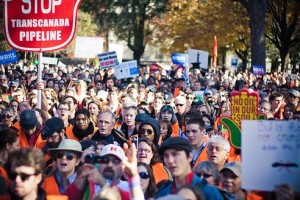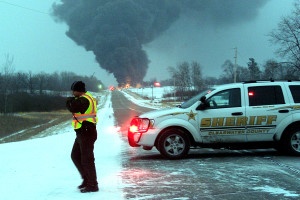We have much more to do and your continued support is needed now more than ever.
Tar Sands Giants Sneaky New Playbook Revealed
Polluters seem to have drawn the wrong lesson from the Keystone XL controversy. Rather than temper the headlong rush to exploit tar sands, they’re getting sneakier. The tactics: gut environmental and public review while breaking up their grandiose proposals into smaller pieces to avoid detection. If they succeed, Americans will be stuck with a massive infrastructure of spill-prone pipelines delivering the dirtiest oil ever around the globe.
Deny Deny Deny

Their departing CEO, Patrick Daniel, showed no remorse and gave no apologies for one of the biggest fossil fuel disasters in North American history. Instead, he sounded frustrated last week, saying he wished the tar sands pipeline business hadn’t become so controversial. Good riddance Mr. Daniel.
Last spring, his company announced a plan to reverse the direction of a pipeline called line 9, so that it could carry crude east rather than west. No big deal, right? What Enbridge didn’t do was show all its cards. The real plan is to send dirty tar sands oil across several Great Lakes and New England states to Portland, Maine, for transfer by ship to refineries or for export. The project, called Trailbreaker, was floated two years ago, and then abandoned when the recession set in.
When local groups in New England announced opposition a few weeks back to piping tar sands near precious rivers in the area, Enbridge reached up its sleeve for the denial card. A spokesman for Enbridge told the Associated Press, “We have been absolutely clear on the fact that the company is not pursuing the Trailbreaker Project.”
That’s not credible. As NWFs Curtis Fisher retorted in the AP article, Enbridge denied it was looking at reversing Line 9, until they went ahead and announced they wanted to reverse Line 9. In fact, the company is salivating at the prospect of moving (by their 2008 estimate) 150,000 barrels of tar sludge a day to Portland.
“We’re pretty excited about [Trailbreaker],” an oil executive said in a 2008 presentation,”because it provides capacity on an as-needed basis, and it involves existing assets so it can be completed at low cost and on a quick turnaround.”
So what’s the truth? Enbridge appears to be playing a dangerous game of denial, putting the pieces in place for a tar sands route to New England, while denying the once and future Trailbreaker (or something by a different name) is happening. Elephant in the room, what elephant?
Divide and Conquer
Meanwhile, another pipeline giant, TransCanada, has split the 2,000 mile Keystone XL into two, in an attempt to move the project piecemeal and shrink the scope of the State Department’s environmental review. Wildlife Promise recently referred to this as divide and conquer:
[A]after Keystone XL was rejected the first time, TransCanada decided to split off the “Gulf Coast segment” of the pipeline, which stretches through Oklahoma and Texas, as a stand-alone project. Because this route doesn’t cross the US border, it avoided the need for the Presidential Permit and the review it entails.
That particular tactic paid off for TransCanada last month, as the Army Corps of engineers gave a green light to construction of XL in Oklahoma and Texas. The oil execs at TransCanada probably had some high-fives last month as well when the State Department announced its new environmental review will ignore the southern segment of Keystone XL.
[Click here to take action and stop latest attempt to resurrect Keystone XL.]
Must History Repeat?
In the summer of 2010, over a million gallons of tar sands oil spilled when an Enbridge pipeline ruptured near Marshall, Michigan, contaminating the Kalamazoo River. Families were driven from their homes and wildlife suffered and died. Responding to the spill, Michigan Congressman Fred Upton said, “Each and every one of us is all too familiar with the devastation wrought by the BP Gulf disaster and now we have a nightmare here in our own backyard. The mistakes and missteps that sabotaged the response and cleanup in the Gulf cannot happen here in southwest Michigan.”
A wonderful sentiment to ride out the news cycle, but Rep.Upton went on to champion Keystone XL, even as the mess persisted in his back yard.
The Environmental Protection Agency ordered Enbridge to clean up the mess, but it is still not cleaned up. Workers are still struggling to remove residual crude oil and are increasingly resigned to the possibility that it may never be cleaned. According EPA’s website, after the spill 39 miles of the river system were closed to public access. By April 17, 2012, three miles–three—had been reopened. Other segments may reopen this year, says EPA, if it is safe.
Accidents in the Trailbreaker pipeline may be more likely because it’s so old. One section is 52 years old, and other large section dates to 1975. A spill from this pipeline could sully rivers, lakes and bays. At risk would be cherished places like Lake Ontario, the Saint Lawrence River, the Connecticut River, the Androscoggin River, Sebago Lake and Casco Bay.
Can We Afford to Trust Enbridge?

Just recently, we learned from media reports that Enbridge has under-estimated the risk of a tar sands spill along its Northern Gateway Project across western Canada, basically ignoring their dismal record in Michigan.
A former insurance CEO, Robyn Allan, concluded that Enbridge does not have “adequate insurance coverage or the corporate structure to cover a multi-billion dollar spill,” reported Andrew Nikiforuk in The Tyee.
‘There is no reason to believe Enbridge would be directly responsible for the cost of any spill based on the limited partnership structure. This structure allows profits to flow to Enbridge, but from what I have seen in the documents, not spill liabilities,’ explains Allan.”
Allan also suggested that Enbridge only minimally understands how the heavy crude oil behaves. It usually sinks to the bottom of a river and is harder to clean up than other fuels.
Allan added that the “company suffers from a corporate culture that places growth as priority above operational safety.” That offers little reassurance to New Englanders. That was made evident when media recently reported that even as the Kalamazoo spill was happening, Enbridge employees, hundreds of miles away had one priority: get the oil flowing. Rather than check for a spill, they attempted to restart the pipeline, not once, but twice.
If Enbridge’s misadventures weren’t so heartbreaking it would be hilarious. Maybe we should call it “Heartbreaker,” not “Trailbreaker.”
[Note: special thanks to NWFs Peter LaFontaine for advice and editing in drafting this post.]





















